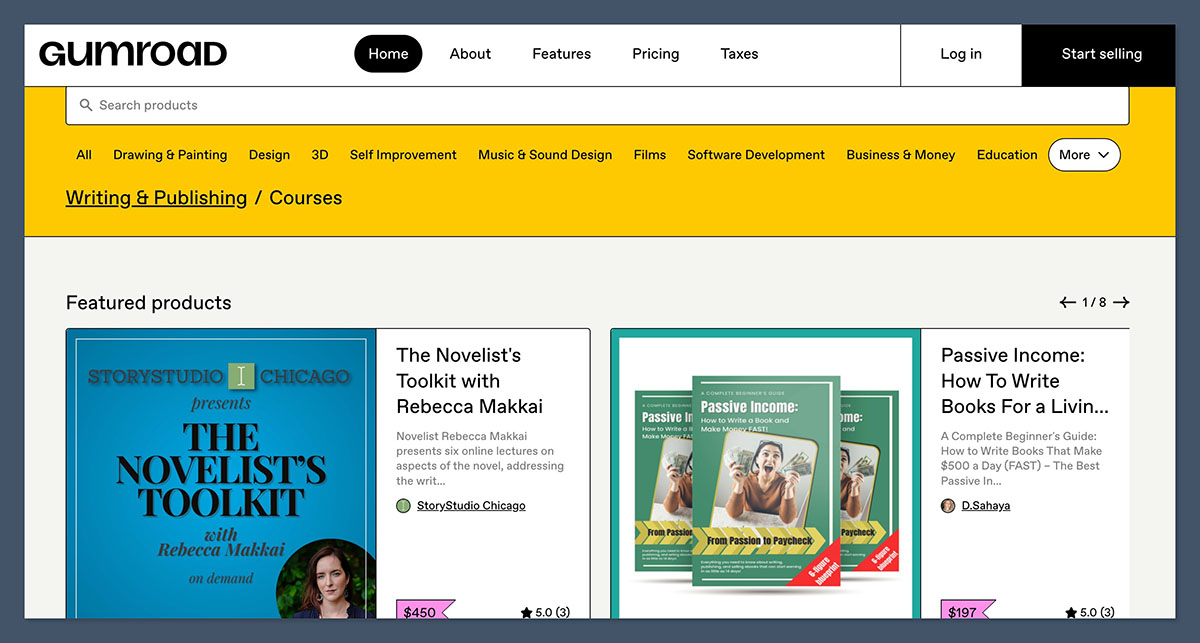Quick answer: Gumroad is a dead-simple way to sell digital products, memberships, and even physical goods.
But if you’re running a full-scale print-on-demand (POD) business, you’re going to hit some walls fast. I’ve used Gumroad for selling art prints, ebooks, and even some low-volume merch.
It works great for solo creators and lean sellers who don’t want to fuss with a full ecommerce stack. But it’s not built for scaling or managing physical inventory at any serious level.
What Is Gumroad?

Gumroad is a no-frills ecommerce platform aimed at creators who want to sell digital files, memberships, or light physical products.
If you’ve ever seen someone selling a Notion template or a zine through a direct link on Twitter, odds are it’s through Gumroad.
I discovered it when I was testing ways to sell digital downloads without paying Shopify-level fees or needing to build a full store.
It’s barebones on purpose. You can sign up, list a product, and start selling in under an hour. There’s no store design to worry about, no themes, and almost no customisation.
For creators just starting out—or folks who hate tech—it’s refreshingly simple. But that simplicity comes with limits.
There’s no inventory tracking, no built-in tax handling for physical goods, and no native integration with print-on-demand services like Printful or Gelato.
So if you’re serious about POD or scaling your ecommerce business, Gumroad might not cut it long-term.
Where Gumroad really shines is in frictionless digital sales. If you’ve got an ebook, a downloadable product, or even a course you want to launch fast, Gumroad’s about as quick and easy as it gets.
Pros and Cons of Using Gumroad for POD Creators
Pros
- Quick setup – Sign up, upload, and sell in minutes
- No monthly fees – Pay only when you make a sale (starts at 10%, drops to 3.5%)
- Built-in audience tools – Email marketing and follower updates included
- Supports digital + physical products – Sell downloads, merch, and subscriptions from one place
- Basic analytics – See what’s selling without digging into reports
- Custom checkout fields – Add customer notes, license keys, or download options
- Instant product delivery – Digital files sent automatically, no need for external tools
Cons
- No direct POD integrations – Printful, Printify, etc. require manual work or Zapier
- Minimal store customisation – One product page, no themes or drag-and-drop builder
- No inventory or shipping tools – Everything must be tracked manually
- Higher fees for new sellers – 10% fee until you pass $1,000 in lifetime sales
- Limited branding options – Gumroad’s branding shows across checkout and emails
- International issues – Currency and tax handling can get messy outside the US
My Experience Using Gumroad for Print on Demand
I used Gumroad to sell some physical art prints and apparel through a Printful integration I hacked together using Zapier.
Let’s just say: it worked, but it wasn’t elegant.
Unlike Shopify or Etsy, Gumroad doesn’t support direct integration with POD tools, which means you’ll need a third-party tool or a manual process to make it happen.
Setting up the store was ridiculously easy. I uploaded product images, added pricing, and set delivery types.
But when I had to manage things like tracking numbers, inventory, or variant pricing (like sizes or colours), things got clunky. It’s fine for selling a few custom tees here and there—but not ideal if you’re shipping hundreds of SKUs.
The customer delivery flow is super clean.
Buyers get a beautiful receipt and product access page, and digital goods are delivered instantly. Physical orders, on the other hand, rely entirely on your fulfilment process.
Gumroad doesn’t track or manage shipping details at all. As a print-on-demand seller, I found myself hitting limitations quickly.
It’s a great MVP tool to validate a product idea or launch something fast. But I wouldn’t rely on it for running a scalable POD business.
That said, if you’re selling a mix of digital and physical products and want something lean, it’s still useful.
Gumroad vs Shopify vs Etsy – What Do You Really Get?
When it comes to ecommerce platforms, you’re probably comparing Gumroad, Shopify, and Etsy.
I’ve used all three across different projects—digital products, POD, and small merch drops—and each one serves a very specific kind of seller.
Gumroad is perfect if you want to start selling in under an hour, don’t need advanced store design, and mostly focus on digital or simple physical products.
Shopify is what I use when I’m ready to scale. It’s a fully-fledged ecommerce system with endless customisation, full POD support, and every tool you’d need to grow a real brand.
Etsy is great if you’re targeting a niche audience, want built-in marketplace traffic, and are okay with playing by Etsy’s rules.
Here’s how they stack up in key areas:
| Feature | Gumroad | Shopify | Etsy |
|---|---|---|---|
| POD Integration | None (manual or Zapier only) | Full support (Printful, Gelato, etc.) | Limited (via integrations or offsite) |
| Customisation | Very limited | Full control | Basic (Etsy branding dominates) |
| Fees | 10% → 3.5% per sale | $29+/mo + ~2.9%/txn | $0.20/listing + 6.5% + payment fees |
| Audience | Bring your own | Bring your own | Built-in traffic, but competitive |
| SEO Control | Minimal | Strong | Weak (Etsy owns search) |
| Digital Products | Excellent | Good | Average |
| Subscription/Memberships | Yes | Via apps | No |
| Best For | Lean solo creators | Scalable ecommerce | Handmade/vintage niche |
Which One Should You Choose?
It really depends on your goals and stage.
Choose Gumroad if you want:
- A fast, free way to sell digital or physical goods
- No upfront costs
- A simple dashboard with minimal learning curve
Choose Shopify if you need:
- Full control of your store, branding, and data
- Built-in tools for growth, analytics, and upsells
- Native POD integrations and fulfilment automation
Choose Etsy if you’re:
- Selling handmade or niche products
- Looking for organic traffic from an established marketplace
- Fine with a bit less control over branding and store setup
My take:
Gumroad works if you want speed and simplicity
Shopify is for building real ecommerce infrastructure.
Etsy is great for organic discovery if you’re making unique stuff.
The smart move is to use them strategically—Gumroad to launch, Shopify to scale, and Etsy to reach niche buyers.
Real Stats From My Store
These are real numbers from my POD experiments using Gumroad:
- $3,271 in total sales in the first six months (selling art prints, a course, and a merch drop)
- 57% of revenue came from a single product bundle (art + digital poster combo)
- 2.9% refund rate — mostly due to physical order delays (manual Printful sync via Zapier)
- $0 in ad spend — I relied 100% on email and Twitter to drive traffic
Conversion rates were strong: around 7.5% on digital-only products, and 3.1% for physical goods (lower due to lack of shipping estimates on the checkout page).
Emails worked well too. Gumroad lets buyers subscribe to product updates, and I had a 25–30% open rate on launch emails.
That built-in audience feature helped me resell and upsell new products without needing Mailchimp or ConvertKit.
If I had been using Shopify with full Printful integration, I’m confident I could’ve doubled physical product sales just from smoother fulfilment and better conversion tracking.
Who Should Use Gumroad?
Gumroad isn’t built to compete with full ecommerce platforms like Shopify.
It’s built for creators who want to get something live fast and don’t need all the bells and whistles. That’s why it works well for certain types of sellers—and falls short for others.
If you’re testing ideas, selling downloads, or just want a clean and low-maintenance way to monetize your audience, Gumroad is probably the right fit.
You Should Use Gumroad If:
- You’re selling digital-first products like:
- Ebooks
- Printables
- Templates
- Wallpapers
- Lightroom presets
- You’re running lean – You don’t want to commit to a monthly fee or manage a full storefront yet.
- You’re testing a new product or market – Gumroad is fast and frictionless, perfect for MVPs or soft launches.
- You want to sell memberships – Set up paid content, newsletters, or communities (Patreon-style) without extra tools.
- You don’t care about advanced branding – The default product pages work fine if you just want to ship and sell.
You Should Not Use Gumroad If:
- You’re doing complex POD with:
- Multiple variants or SKUs
- International shipping
- Order tracking and fulfilment workflows
- You need full creative control over your store’s design, user experience, or checkout process.
- You rely on native integrations for:
- Print-on-demand platforms
- CRMs
- Analytics, pixels, and marketing automation
- You plan to run ads and want to track conversions tightly across Facebook, Google, or TikTok.
Ideal Use Cases (Quick Overview)
| Use Case | Is Gumroad a Fit? | Why / Why Not |
|---|---|---|
| Selling ebooks or digital art | Perfect fit | Instant delivery, no monthly fee |
| Selling t-shirts via Printful | Not ideal | No native POD integration |
| Testing a new product idea | Great option | Launch fast, no setup time |
| Running Facebook ads | Look elsewhere | Lacks advanced pixel tracking |
| Starting a membership site | Works well | Built-in recurring payments |
I’ve recommended Gumroad dozens of times to creators launching info products, indie authors, or visual artists.
But once they start scaling or want more control? I point them to Shopify or WooCommerce without hesitation.
Final Thoughts – Would I Use Gumroad Again?
Absolutely—but only for the right type of project.
I still use Gumroad to this day for a few side-product launches, like downloadable design templates and bundled merch kits. For quick drops, micro-products, or MVPs? It’s perfect. Low setup time, no overhead, no stress.
But for my core POD business? No way. I need Printful, order tracking, automated fulfilment, upsells, customer tags, abandoned cart recovery, the works. And that’s not what Gumroad is built for.
Here’s how I’d break it down:
- Use Gumroad to start lean, test ideas, and launch fast
- Switch to Shopify or WooCommerce when you need scalability, control, and integrations
Just be clear on what game you’re playing. Gumroad isn’t a full ecommerce platform. It’s a direct sales tool for creators. And it plays that role well.






